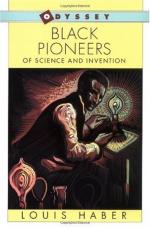|
This section contains 457 words (approx. 2 pages at 400 words per page) |

|
Black Pioneers of Science and Invention Summary & Study Guide Description
Black Pioneers of Science and Invention Summary & Study Guide includes comprehensive information and analysis to help you understand the book. This study guide contains the following sections:
This detailed literature summary also contains Topics for Discussion and a Free Quiz on Black Pioneers of Science and Invention by Louis Haber.
"Black Pioneers of Science and Invention" by Louis Haber is a work of nonfiction designed to introduce the inventions and contributions of fourteen African American men dating from the 18th to 20th centuries. The accomplishments range from engineering to medicine and beyond. Haber points out that while the inventions of these pioneers are internationally known, the scientists themselves are all but forgotten.
Four years of research and writing has allowed Haber to create a subjective view of the doctors and inventors in the book, particularly in light of the obstacles each had to overcome in order to live out his dream.
Much of the book, which is written to capture the attention of a young adult reader, is geared toward the actual work created by the Pioneers as well as their inventions and contributions to science. Haber does add interesting background information to give each of the Pioneers a sense of character instead of merely presenting each as a figurehead with no past or personality. Often times, the Pioneer's history sheds light on the man's drive to succeed.
The book focuses on: Benjamin Banneker (1731-1806), a black surveyor responsible for assisting in the design of Washington DC; Norbert Rillieux (1806-1894), the creator of the system in which sugarcane juice is refined and crystallized; Jan Earnst Matzeliger (1852-1889) the inventor responsible for revolutionizing the manufacturing process for shoes; Elijah McCoy (1844-1929) was an engineer who developed automatic lubrication devices for machinery; Granville T. Woods (1856-1910), also known as the "Black Edison," was responsible for many important inventions involving electricity; Louis Howard Latimer (1848-1928), an expert draftsman and assistant to Alexander Graham Bell and Thomas Edison; Garrett A. Morgan (1877-1963), inventor of the "Safety Hood," the apparatus that evolved into the gas mask; George Washington Carver (1860-1943), an American agricultural chemist best known for his work in the field of agriculture; Percy Lavon Julian (1899-1975), a scientist often referred to as the "soybean chemist" due to his work in converting the legumes into a variety of innovative products; Lloyd A. Hall (1894-1971), an expert in the development of food technology; Ernest Everett Just (1883-1941), a marine biologist known for his work with cells; Daniel Hale Williams (1856-1931), the first surgeon to ever perform heart surgery; Louis Tompkins Wright (1891-1952), a pioneer in medicine, the first black surgeon of the New York City police department and the first black doctor appointed to the New York Municipal Hospital; and Charles Richard Drew (1904-1950), a physician and researcher involved in the advancement of blood transfusions.
As an educator and scientists, Haber saw a definite lack in information regarding African American inventors and scientists. Haber's book was written to better inform young students about these great contributors to science.
Read more from the Study Guide
|
This section contains 457 words (approx. 2 pages at 400 words per page) |

|



